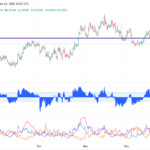EUR/USD remains on the back foot in the European session on Wednesday and trades below 1.1650 after losing about 0.5% on Tuesday. The technical outlook suggests that sellers are likely to retain control in the near term.
Euro Price This week
The table below shows the percentage change of Euro (EUR) against listed major currencies this week. Euro was the weakest against the Canadian Dollar.
| USD | EUR | GBP | JPY | CAD | AUD | NZD | CHF | |
|---|---|---|---|---|---|---|---|---|
| USD | 0.89% | 0.25% | 2.22% | -0.04% | 0.30% | 0.89% | 0.53% | |
| EUR | -0.89% | -0.73% | 1.24% | -0.95% | -0.61% | -0.02% | -0.38% | |
| GBP | -0.25% | 0.73% | 2.07% | -0.22% | 0.12% | 0.70% | 0.35% | |
| JPY | -2.22% | -1.24% | -2.07% | -2.15% | -1.91% | -1.36% | -1.68% | |
| CAD | 0.04% | 0.95% | 0.22% | 2.15% | 0.38% | 0.94% | 0.57% | |
| AUD | -0.30% | 0.61% | -0.12% | 1.91% | -0.38% | 0.58% | 0.23% | |
| NZD | -0.89% | 0.02% | -0.70% | 1.36% | -0.94% | -0.58% | -0.35% | |
| CHF | -0.53% | 0.38% | -0.35% | 1.68% | -0.57% | -0.23% | 0.35% |
The heat map shows percentage changes of major currencies against each other. The base currency is picked from the left column, while the quote currency is picked from the top row. For example, if you pick the Euro from the left column and move along the horizontal line to the US Dollar, the percentage change displayed in the box will represent EUR (base)/USD (quote).
The broad-based US Dollar (USD) strength caused EUR/USD to push lower on Tuesday as markets overlooked another failed vote to pass the funding legislation.
Early Wednesday, outgoing French Prime Minister Sebastien Lecornu noted that he was optimistic about reaching a budget deal by the end of the year, easing concerns over a snap election. “There is a willingness to have a budget for France before December 31 of this year,” Lecornu told reporters after meeting conservatives and center-right parties, per Reuters. Although this development seems to be helping the Euro hold its ground, there are no signs of a steady recovery as of yet.
The economic calendar will not offer any high-impact macroeconomic data releases later in the day. Hence, investors are likely to remain focused on political developments.
Senate Majority Leader John Thune said that they will present the same bill over and over again, suggesting that a deal could be hard to come by anytime soon. Meanwhile, the White House’s Office of Management and Budget reportedly sent a memo, noting that the 750,000 furloughed workers are not guaranteed back pay.
While the negative impact of the uncertainty created by the US government shutdown on the USD seems to be fading away, investors could turn reluctant to bet on additional USD gains if a prolonged shutdown continues to force key data to be postponed.
EUR/USD Technical Analysis

The Relative Strength Index (RSI) indicator on the 4-hour chart remains well below 40 and EUR/USD trades below the 100-day Simple Moving Average (SMA), currently located at 1.1630, for the first time since March, reflecting a bearish stance.
In case EUR/USD fails to reclaim 1.1630, technical sellers are likely to remain interested. In this scenario, 1.1580 (Fibonacci 61.8% retracement of the latest uptrend) could be seen as the next support level before 1.1500 (round level, Fibonacci 78.6% retracement).
On the flip side, a strong resistance area seems to have formed at 1.1700-1.1715 (Fibonacci 38.2% retracement, 200-period SMA) if EUR/USD manages to stabilize above 1.1630.
Euro FAQs
The Euro is the currency for the 19 European Union countries that belong to the Eurozone. It is the second most heavily traded currency in the world behind the US Dollar. In 2022, it accounted for 31% of all foreign exchange transactions, with an average daily turnover of over $2.2 trillion a day.
EUR/USD is the most heavily traded currency pair in the world, accounting for an estimated 30% off all transactions, followed by EUR/JPY (4%), EUR/GBP (3%) and EUR/AUD (2%).
The European Central Bank (ECB) in Frankfurt, Germany, is the reserve bank for the Eurozone. The ECB sets interest rates and manages monetary policy.
The ECB’s primary mandate is to maintain price stability, which means either controlling inflation or stimulating growth. Its primary tool is the raising or lowering of interest rates. Relatively high interest rates – or the expectation of higher rates – will usually benefit the Euro and vice versa.
The ECB Governing Council makes monetary policy decisions at meetings held eight times a year. Decisions are made by heads of the Eurozone national banks and six permanent members, including the President of the ECB, Christine Lagarde.
Eurozone inflation data, measured by the Harmonized Index of Consumer Prices (HICP), is an important econometric for the Euro. If inflation rises more than expected, especially if above the ECB’s 2% target, it obliges the ECB to raise interest rates to bring it back under control.
Relatively high interest rates compared to its counterparts will usually benefit the Euro, as it makes the region more attractive as a place for global investors to park their money.
Data releases gauge the health of the economy and can impact on the Euro. Indicators such as GDP, Manufacturing and Services PMIs, employment, and consumer sentiment surveys can all influence the direction of the single currency.
A strong economy is good for the Euro. Not only does it attract more foreign investment but it may encourage the ECB to put up interest rates, which will directly strengthen the Euro. Otherwise, if economic data is weak, the Euro is likely to fall.
Economic data for the four largest economies in the euro area (Germany, France, Italy and Spain) are especially significant, as they account for 75% of the Eurozone’s economy.
Another significant data release for the Euro is the Trade Balance. This indicator measures the difference between what a country earns from its exports and what it spends on imports over a given period.
If a country produces highly sought after exports then its currency will gain in value purely from the extra demand created from foreign buyers seeking to purchase these goods. Therefore, a positive net Trade Balance strengthens a currency and vice versa for a negative balance.





















